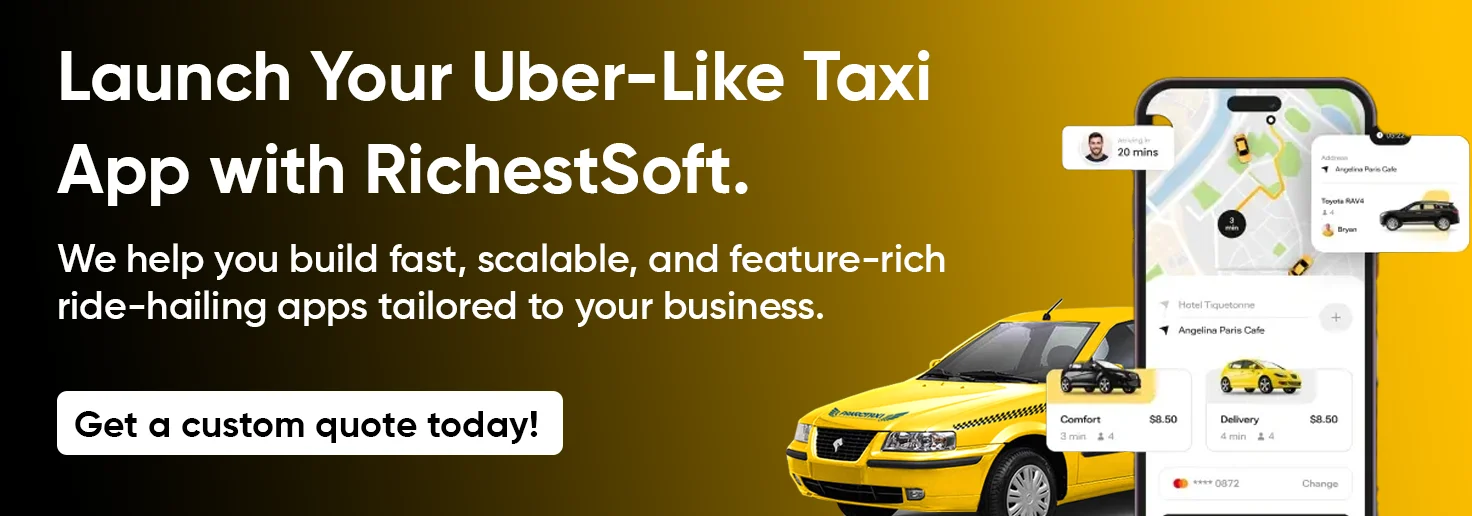October 23, 2025
Uber is a famous taxi app that allows you to book fast, reliable rides in just a few minutes, whether it’s day or night. There is no need to park your car or wait for a taxi or bus. With the help of this app, you just tap to request a ride and book it in an easy way. It further offers easy payment options such as cash, credit, or other wallet apps in selected cities. Bridging the gap between riders and drivers through its Android and iOS apps, it forms an on-demand connection.
There are many taxi app service companies that want to create an app like Uber. Starting your own taxi app is exciting, but it’s not simple. You need something that passengers can use without hassle, drivers can rely on, and that can grow as your business grows.
Keep reading the blog to know what it takes to turn your taxi business app idea into a reality.
Things to Know About Uber-Like App Development
When you think of taxi apps, the first one that probably comes to mind is Uber. Uber currently operates in over 70 countries, providing a 24-hour on-demand connection between riders and drivers through the Android and iOS apps.
Based on availability, there is a choice of various levels of Uber service:
- GO – the most cost-efficient option.
- XL – classy Uber with chic cars.
- Premier – Luxury rides with high-end cars.
- Pool – when you want to share a ride.

Thanks to a sound business model and high customer demand, Uber has seen near-exponential growth in revenue and in its user base.
How Does Uber Work?
If you want to make an Uber clone app, you should be aware of how the service works on the customer side. The general app performance can be shown in five simple steps:

Step #1: Make a Request
The customer requests a car instantly or schedules via the app. Nearby drivers receive requests.
Step #2: Matching
The driver may either accept or reject the ride. If they reject it, the request is sent to another driver.
Step #3 Booking Confirm
When the request is accepted, the customer tracks the taxi’s path and knows the estimated time of arrival.
Step #4: Payment
The cashless way of payment and the price estimated beforehand make this process smoother for both parties.
Step #5: Rating
It is an important component of Uber’s business logic that enhances service reliability.
If you are striving to create your own Uber app or its counterpart, then there is a need for two apps. The original platform consists of the Driver App, designed for drivers collaborating with the company and the Passenger App, meant for ordinary customers who book their rides. Apart from that, the platform should also come with an admin panel that is capable of managing and monitoring the platform’s work. Let us have a look at some of the key types and features of the app.
1. Passenger app
- Booking interface: It shows you the interface where you can book your cab according to the requirements.
- Register page: The registration process in the app can be done through email or phone number.
- Ride history: You can also check your past history along with travel, time, and cost estimation.
- Payment page: In this app, you can select from multiple payment options according to your comfort level.
- Push notification: This feature informs the user even when they are not using the app.
- Fare calculator: You can choose any of the available options according to the fare display. If you feel the fare is high, opt for another option.
- Rating & Review: After completing your trip, you can give a review to the driver.
2. The Driver app
- Book a ride: The nearby drivers will get your request, and the one who accepts it will be shown on your interface.
- Driver profile & detail: Verification and profile creation should be done from the admin side. The status will let the admin know about the availability of the driver.
- Pick up & drop location: It will inform the driver regarding the user’s pick-up and drop location.
- Booking alert (push notification): It will alert the driver to see a request by the user to accept or deny the same.
- Navigation & mapping: It suggests the best route to the drivers using Google Maps.
3. Admin panel
Web app/Dashboard to show, manage, and review all the in-app activity.
- It offers an overview of all the processes.
- Suggests the best navigation for drivers and trips.
- Manages revenue and payroll, and collects data on clientele for further enhancements.
How Much Does An Uber-Like App Cost?
Certainly, Uber’s business model has led to a significant increase in the number of On-Demand Platforms. Being adopted across various verticals, the Uber clone app is highly in demand, encouraging many entrepreneurs to build Uber clone solutions to tap into this growing market.
If you have plans to create your own Uber-like app, first, you need to understand the factors that will affect the Uber Clone App Cost.
1) Major Cost Components: It is essential to learn about the leading costing aspects of Uber-like app development.
- UI/UX Design
- Web development
- Backend development
- Third-party service APIs integrations
- Post-deployment maintenance & Quality assurance
2) Tools and technologies to build the Uber clone app: While Uber has its unique API for developers, you just need the original elements of the server and map payments. To process thousands of driver routes, user requests, and daily data, you need a reliable server.
For the programming languages, you can choose between OpenStreetMap API or iOS and Android for GPS. For the backend, you can pick Node.js, Java, Python, or PHP.
3) Platform-specific APIs: You can trust Google Maps and Google Location Services API for the Android version. When working for iOS, you can switch to the MapKit or the CoreLocation framework.
4) In-app Payment solutions: It is important to have robust In-app payment solutions for credit cards and Wallets. If you want to deploy for third-party gateway integrations, there can be options like Stripe, PayPal Mobile SDK, etc.
5) Backend development: When it comes to a perfect architecture of an on-demand app, the backend plays a crucial role in the effective functioning of the app, but it calls for extra effort and money.
6) Platform choice (Native iOS/Android): You need an app like Uber that offers a seamless user experience and uninterrupted performance. Here, you can simplify the process by choosing the right software development company capable of building native apps. This means that with the same backend and functionality, you will have both your iOS and Android versions performing well.
Summarizing the factors influencing the Cost to build Taxi App, the total cost will depend greatly on hourly rates.
While in the USA, the rates are somewhere between $100-$200, you can consider Asian countries where it can be more affordable. You can easily get it done for a rate of $50 or $40 per hour.
Benefits of Uber Apps

1. Reliable and Cashless
Rather than chasing a taxi in the street or waiting for a long time for a car service, Uber is the better option to book a cab immediately from any location.
Because the passenger’s credit card or other payment options are linked to the Uber account, the payment is cashless. If you want to pay with cash, you can.
2. Professional Service
In major cities, where taxi services are highly in demand, they mostly use the latest car models that are well-maintained and handled by professionals who have proper commercial insurance coverage.
Once a driver accepts an assignment, passengers are able to track a driver’s location and route and interconnect with their driver if necessary. A driver only learns the passenger’s destination when the fare starts.
3. Safer and More Flexible for Drivers
Safety is the most important advantage for drivers who are working with Uber. Rude, aggressive, and disruptive passengers are weeded out because drivers can also rate their customers. Consistently low ratings or reports of unsafe behavior toward drivers can cause the deactivation of an account.
Drivers can avoid expensive taxi rental leases by acquiring their own vehicles. This means more profit for drivers, all else being equal. Drivers are also spared the stress caused by favoritism and office politics because the app renders dispatchers irrelevant.
4. Discount Offers
Uber also gives offers to their regular customers and to customer who signs up for the first time.
5. Book a Ride for Other People
Booking a ride for others is an advanced feature for Uber-like apps. It implies that a user can book a ride for a relative or friend through their own account.
As soon as the booking is made, the friend or relative receives the ride details via SMS, the same as the driver.
Final Thoughts
As app development and QA are the most time-consuming phases, you can expect the approximate cost range to create an Uber-like app to be somewhere between $25000 and $30000 for a single platform. Nevertheless, this totally depends on your needs and the specifications you are looking for. Do you need some help to develop an Uber-like app ? Consult the best Uber clone app development company, like RichestSoft, to build a Taxi Booking App Like Uber.
FAQs
Q1:How do I actually start building a taxi app?
A: You don’t need to know everything upfront. Just tell us your idea, and we’ll handle the tech side—design, coding, payments, driver tools, everything. You focus on your business, we focus on the app.
Q2:Can my app be different from Uber?
A: Totally. We can add custom things like special promotions, loyalty points, or flexible pricing. You can make it your own instead of copying someone else.
Q3:How long until I can start taking rides?
A: It depends on the features you want. Most apps are ready in a couple of months. We try to keep it fast so you don’t lose momentum.
Q4:What if my app becomes popular quickly?
A: No problem. We build apps that scale. More users, more drivers, more cities—your app can handle it without breaking or slowing down.
Q5: Will it work on every phone?
A: Yes. Both Android and iPhone users get the same smooth experience. Drivers and passengers won’t have any issues using it.
 +1 315 210 4488
+1 315 210 4488 +91 99888 06489
+91 99888 06489







